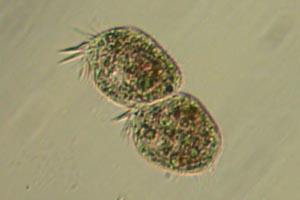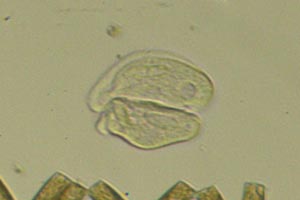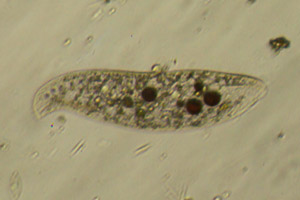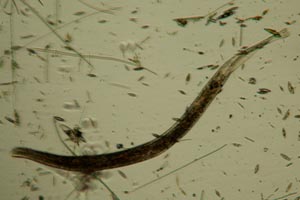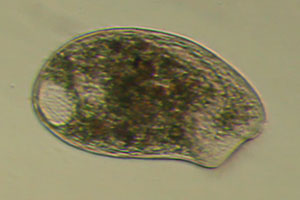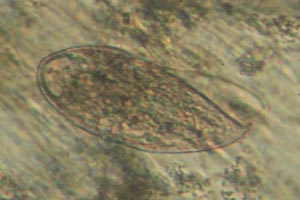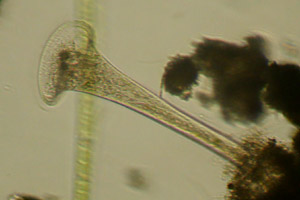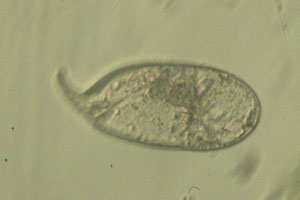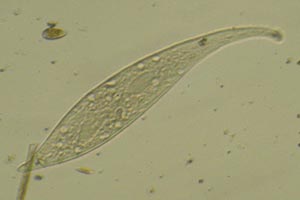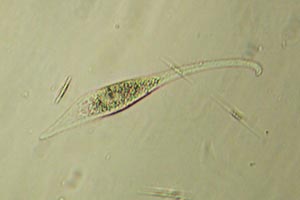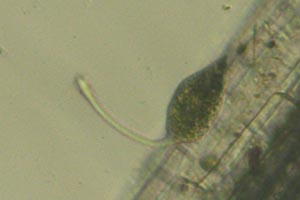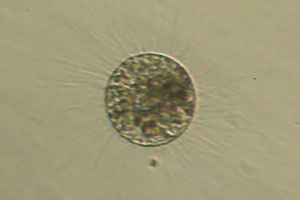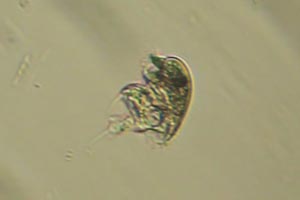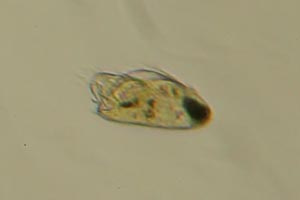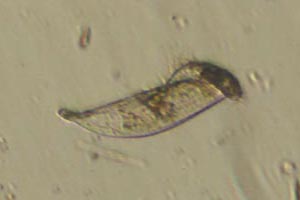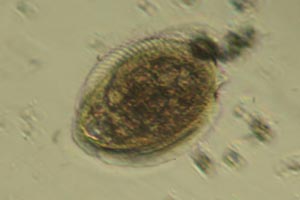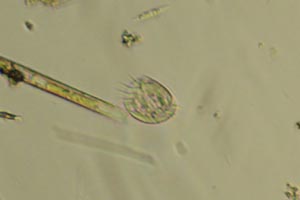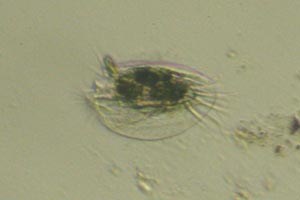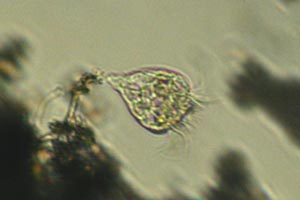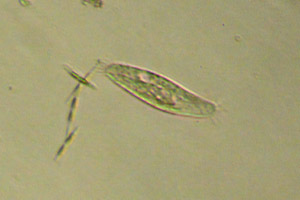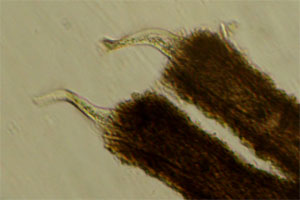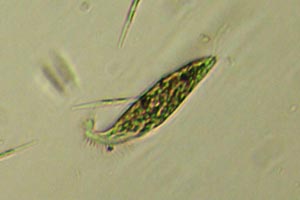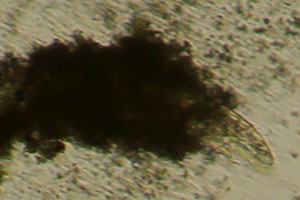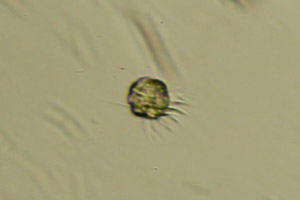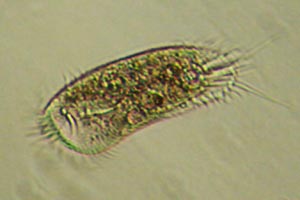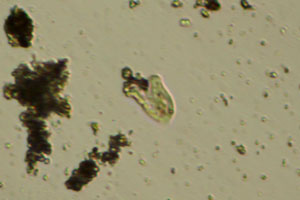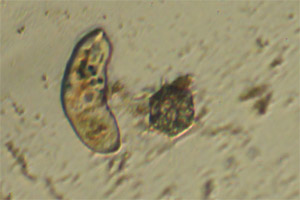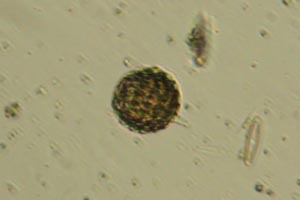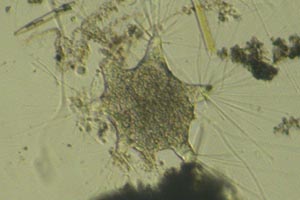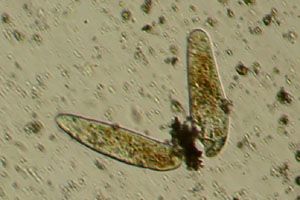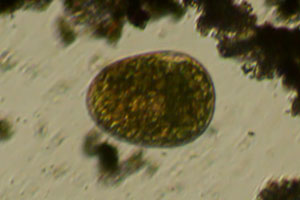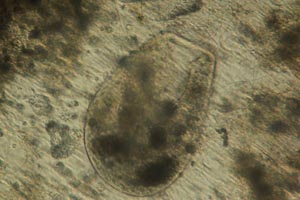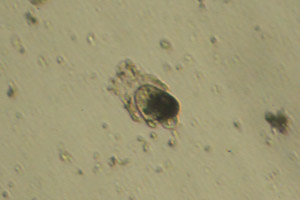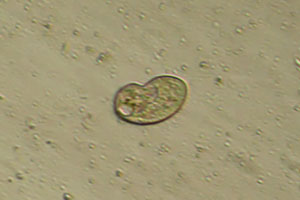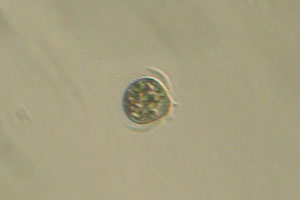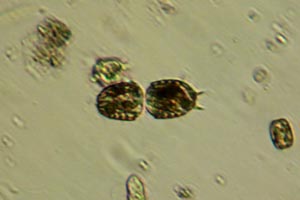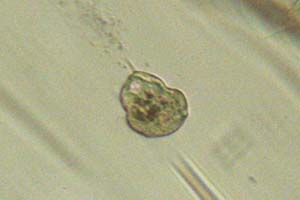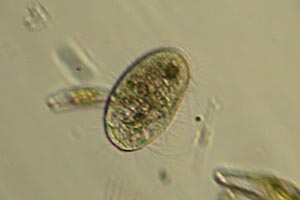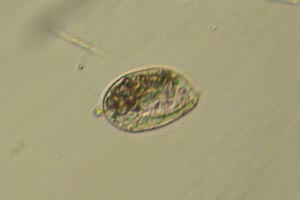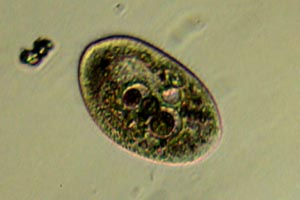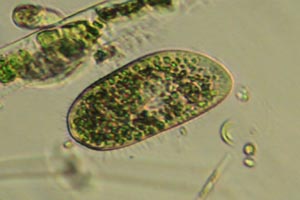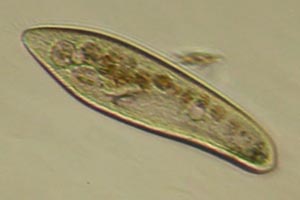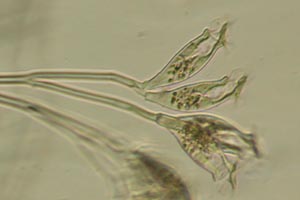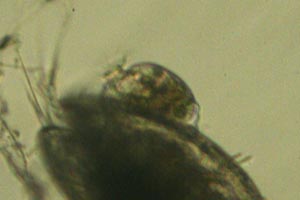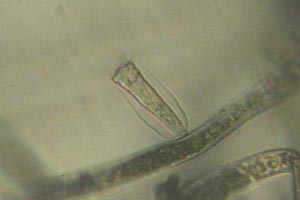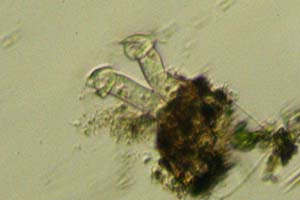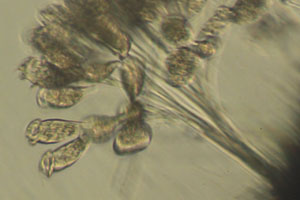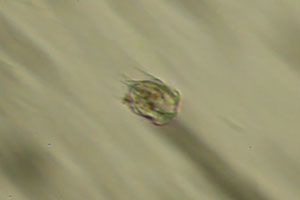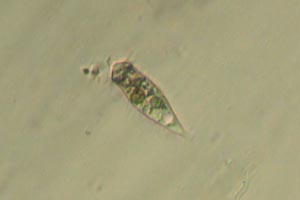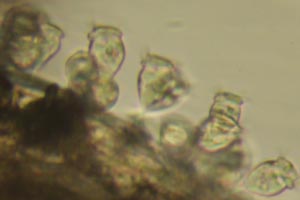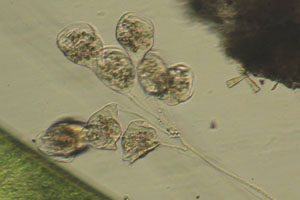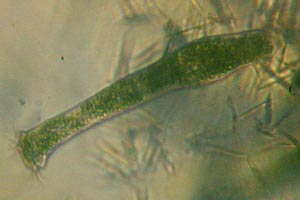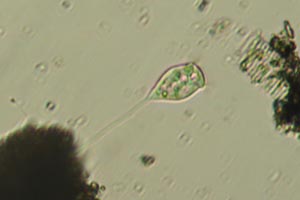Kingdom Chromista, Phylum Ciliophora
Ciliates are some of the most widespread and conspicuous single-celled organisms. Most are recognized by their cilia: short flagella arranged in rows, clumps, or fused together to form compound structures. These may be used for movement, feeding, or sometimes sensation or attachment.
Most ciliates have a distinct mouth where ingestion takes place, forming food vacuoles, which generally circulate the cell on a set path before being discharged. Different sorts eat prey from bacteria to small animals, or are symbiotic with larger animals. There are also various species that contain zoochlorellae, i.e., symbiotic green algae.
Dividing ciliates usually separate front-to-back. They are unique in having different micronuclei, which undergo mitosis, and macronuclei, which do not and eventually degrade. New macronuclei are formed as part of conjugation, where two cells line up and exchange genes, but typically without fusing or forming gametes.
Class Karyorelictea
Karyorelictea are long and flattened with a simple mouth or indefinite region where food is ingested. Unlike other ciliates the macronuclei are mainly diploid. They are most common in marine sediments, preferring low oxygen levels, and at least some are capable of respiration using nitrate instead.
Loxodes
Greek loxos, oblique
Angl. lok-SOH-deez
Loxodes live in freshwater and have an indented mouth just behind the front end, which is distinctively hooked. Most are omnivorous and some have zoochlorellae.
Class Heterotrichea
Heterotrichea have compound cilia called membranelles, which usually run along the front of the cell and clockwise into its mouth. These are involved in collecting food, mainly bacteria and small algae or sometimes protozoans, and often in movement as well. The rest of the cell is covered with simple cilia in rows.
Spirostomum – worm ciliates
Greek speira, coil, stoma, mouth
Angl. spy-ROS-to-mum
Spirostomum are worm-like, with the mouth on one side and a large water expulsion vesicle at the posterior. The body is flexible and can contract several times in length.
These include some of the longest ciliates, reaching 2-4 mm, but other species are smaller and may be less than a tenth as long.
Climacostomum
Greek klimax, ladder, stoma, mouth
Angl. KLY-ma-KOS-to-mum
Climacostomum are oval and flattened. The membranelles run in a semicircular arc over a small bulge, curving around a ventral mouth with a deep pharynx.
Blepharisma
Greek blepharon, eyelid
Angl. BLEF-a-RIZ-ma
Blepharisma have oral membranes in a line back to the mouth near the midline of the cell. Most kinds are a pink, reddish, or rarely bluish colour, especially in darker conditions.
Stentor – trumpet ciliates
After Stentōr of Greek myth
Angl. STEN-tor
Stentor are conical with membranelles circling the front rim. The posterior end usually anchors them while feeding, and they can contract rapidly when disturbed, similar to some rotifers.
Different kinds vary greatly in size, from about 200 µm to 2 mm when extended. They include some species that form mucilage tubes, and some that normally have green zoochlorellae.
Many more have blue, red, or brownish pigments. These help them detect and avoid light, but also act as photosensitizers, which are some deterrent to predators.
Class Litostomatea
Litostomatea are mainly either predatory or endosymbiotic in animals. The former have an oval or slit-like mouth, which is usually supported by pharyngeal rods, and is surrounded by minute bodies called toxicysts that help seize and paralyze prey. Most feed on other ciliates and protozoans, and some also eat small algae or animals.
Tracheliids and dileptids have a trunk at the front end of the cell, which is typically movable though not contractile. The mouth itself is set at its base but the oral toxicysts and cilia extend along its whole length.
Trachelius
Greek trachēlos, neck
Angl. tra-KEE-leeus
Trachelius are ovoid with a short spout-like trunk, which has a groove leading to the mouth. They are often largely clear from inflated vacuoles, making the bipartite nucleus easier to see.
Dileptida
Greek dis, twice, leptos, thin
Angl. di-LEP-ti-da
Dileptida have well-developed, flexible trunks that sweep back and forth in search of prey. In most the body is also long and slender, though some planktonic kinds are more compact.
Pleurostomatida are generally slender and flat. The front end is tapered and normally curved to one side, with the mouth running along its outer edge, and in larger species may form an extensible proboscis.
Amphileptus
Greek amphi, on both sides, leptos, thin
Angl. AM-fi-LEP-tus
Amphileptus usually have multiple water expulsion vesicles, which form a row along each edge of the cell. They are often relatively large, a few kinds reaching 300-800 µm in length.
Litonotus
Greek litos, plain, nōton, back
Angl. LYE-to-NOH-tus
Litonotus usually have a pointed posterior with a single water expulsion vesicle. Some are notably contractile, while several smaller species have raised ribs along the back.
In most other free-living litostomes the mouth is marked by an anterior lip or bulge containing the toxicysts. They vary considerably in other respects, ranging from flexible and worm-like to fast oval ciliates.
Monodinium
Greek monos, one, dinos, whirling
Angl. MON-o-DIN-eeum
Monodinium are fast swimmers with their body cilia reduced to a single ring near the front. The mouth is on a short central projection, seizing and engulfing prey as large as themselves.
Lacrymaria – tear ciliates
Latin lacrima, tear
Angl. LAK-ri-MAIR-eea
Lacrymaria have their mouth at the end of a long flexible neck. This is often straight during swimming but can also dart around very quickly and stretch several times in length.
Actinobolinidae
Greek aktis, ray, -bolos, throwing
Angl. ak-TIN-o-bo-LIN-i-dee
Actinobolinids are round or oval, often resting mouth down, with a uniform covering of both cilia and fine ray-like tentacles. The latter have toxicysts and serve to pull in captured prey.
Class Armophorea
Armophorea are similar to heterotrichs, but free-living kinds are usually flattened with cilia in short rows or tufts, or else more or less twisted. They are anaerobic and only live in low-oxygen habitats, such as decomposition-rich mud or the digestive tracts of animals.
Caenomorpha
Greek kainos, new, morphē, form
Angl. SEE-no-MOR-fa
Caenomorpha have oral cilia wound around the body, giving them a spinning motion. The front is cap-shaped, with cilia in tufts, and they have one or two posterior spines.
Brachonella
After Simone Villeneuve-Brachon, published c. 1930s
Angl. BRASH-o-NEL-a
Brachonella have membranelles in a groove making a full turn around the cell, from near the front to a posterior mouth. The cilia are in twisted rows and there are usually no spines.
Metopus
Greek metōpon, forehead
Angl. me-TOH-pus
Metopus are elongate to rounded with cilia in rows. The front end is usually bent or to the left of the membranelles, which run back in a diagonal groove as far as the midline of the cell.
Class Spirotrichea
Spirotrichea have a prominent series of membranelles similar to heterotrichs, but in most the body cilia are reduced or absent, or else fused to form compound tufts called cirri. The latter are used like small feet for crawling over soil particles, algae, and other surfaces, and generally visible even under lower magnifications.
Phacodinium
Greek phakos, lentil, dinos, whirling
Angl. FAK-o-DIN-eeum
Phacodinium are flattened side-to-side with a long series of membranelles running to a posterior mouth. The body is stiff and ridged, with cilia in groups but not true fused cirri.
Aspidisca
Greek aspis, shield, -iskē, dimn.
Angl. AS-pi-DIS-ka
Aspidisca are small and flat, usually less than 50 µm long. The membranelles form an inconspicuous row on the left side, not reaching the front, and the cirri are in ventral clusters.
Euplotes
Greek eus, good, plōtos, floating
Angl. yoo-PLOH-teez
Euplotes have prominent membranelles that run around the front end of the cell, with cirri in ventral clusters. Many live in freshwater or soil, while most other such ciliates are marine.
Strobilidium
Greek strobilos, spinning top, -idion, dimn.
Angl. STROB-i-LID-eeum
Strobilidium have membranelles in a complete circle around the front end. The cells are conical, and often trail a mucous thread that holds them in place while they spin.
Holosticha
Greek holos, whole, stichos, row
Angl. ho-LOS-ti-ka
Holosticha from freshwater are flat and narrow. The front end is typically turned to its left, and unlike similar types, the water expulsion vesicle sits behind the midline of the cell.
Chaetospira
Greek chaitē, long hair, speira, coil
Angl. KEE-to-SPY-ra
Chaetospira are narrow and contractile with membranelles winding around the front end. They live in secreted loricas or tubes, with cirri in spiral rows but not conspicuous.
Stichotricha
Greek stichos, row, thrix, hair
Angl. sti-KOT-ri-ka
Stichotricha are spindle-shaped with membranelles running straight back from the front tip. They secrete tubes but are often found without them, and some also have zoochlorellae.
Atractos
Greek atraktos, spindle
Angl. a-TRAK-tos
Atractos are cylindrical with a thin pointed tail and spiral rows of inconspicuous cirri. The membranelles run along a short oral groove, apparently involved in rooting through sediment.
So far these have only been reported a few times in eastern Europe and the Alberta puddles here.
Halteria – jumping ciliates
Greek haltēr, jumping weight
Angl. hal-TEER-eea
Halteria are round with several fine cirri or bristles, formed from only one or two cilia. These are used for a characteristic jumping movement, where the cells abruptly change direction.
Stylonychia – mussel ciliates
Latin stilus, style, Greek onyx, claw
Angl. STY-lo-NIK-eea
Stylonychia are flat and inflexible with cirri on the margins and underside. The front end is usually widened to one side, and the rear has three long and distinctly separated caudal cirri.
Class Phyllopharyngea
Phyllopharyngea share strips called phyllae lining the mouth, which often has pharyngeal rods linked to form a rigid oral basket. Mobile cells have simple cilia in rows over part or all of the body, but typically no compound cilia. Attached kinds are more derived and usually have reduced cilia or even none.
Phascolodon
Greek phaskōlos, wallet, odōn, tooth
Angl. fas-KOL-o-don
Phascolodon are free-swimming. The cell is warped into an odd shape like a cracked bell, with a central hollow open at the front and in a cleft down one side.
Suctorians are unique both in lacking cilia, except for mobile swarmer cells, and in having multiple mouths in the form of tentacles. Most live attached to aquatic animals or other objects and feed mainly on passing ciliates, though some are free-floating or parasitic. The tentacles adhere to prey and drain fluid from them.
Metacineta
Greek meta, among or after, akinētos, motionless
Angl. MET-a-si-NEE-ta
Metacineta are enclosed in a clear lorica. This opens in several radial slits around the top, each admitting a line of tentacles. The other end typically forms a pointed attachment.
Cysts: Podophrya
Greek pous, foot, ophrys, brow
Angl. po-DOF-reea
Podophrya are round suctorians with distinctive resting cysts. These are spherical with a set number of circular ribs spaced between two poles, one of which has a short stalk.
Dendrosoma
Greek dendron, tree, sōma, body
Angl. DEN-dro-SOH-ma
Dendrosoma have their tentacles in clusters on short to long finger-like projections. The cell body forms a broad attachment and in some develops into large upright branches.
Class Nassophorea
Nassophorea have tube-like mouths set behind the front and supported by a rigid oral basket. There are either a few compound cilia next to it or a series extending to its left. Most larger types feed on filamentous cyanobacteria, filling them with blue-green, orange, or other distinctly coloured vacuoles.
Nassulopsis
Greek opsis, appearance, with Nassula
Angl. NAS-yu-LOP-sis
Nassulopsis are slender with rounded ends. They differ from others in having several water expulsion vesicles, arranged in a line behind the mouth.
Nassulida
Latin nassa, fish-basket, -ula, dimn.
Angl. nas-YOO-li-da
Nassulida are mostly ovoid with a large mouth and single water expulsion vesicle, set to the side. Some also have a margin of small rod-like trichocysts like peniculids.
Class Colpodea
Colpodea are mainly free-living ciliates with their mouth set in a ciliated vestibule, varying from small and lateral to large and anterior. This contains both compound oral cilia and paired somatic cilia, with the latter extending over the rest of the body.
Bursaria – purse ciliates
Latin bursa, purse
Angl. bur-SAIR-eea
Bursaria are omnivores with a deep oral cavity. This opens at the front end and along a ventral cleft, then curves in a crescent back and toward the left side of the ovoid body.
These are relatively large, from about 200 µm to over 1½ mm, with only small water expulsion vesicles around the margins.
Maryna
After Mary Weismann (née Gruber), 1848-1886
Angl. ma-RYE-na
Maryna are dome-shaped with only a short ciliated projection behind the mouth. They secrete gelatinous tubes from the front, sometimes in colonies, and are peculiar to transient puddles.
Colpodidae
Greek kolpos, gulf
Angl. kol-POD-i-dee
Colpodids are kidney-shaped with a groove on the right leading into a small mouth. The front end is twisted so water is funneled past it, bringing in food like bacteria and algae.
These are especially common in terrestrial habitats like wet soil, leaf litter, infusions of plant material, and so on. Division takes place inside cysts.
Class Prostomatea
Prostomatea are more or less ovoid with a round mouth at the front end, usually associated with toxicysts and a brosse of inconspicuous compound cilia. Most otherwise have simple cilia in rows. In division a second mouth forms on one side and moves to the front once the daughter cells split.
Askenasia
After Eugen Askenasy, 1845-1903
Angl. AS-ke-NAY-zeea
Askenasia have cilia close around the mouth, including a prominent ring of longer sickle-like projections. These propel the cell in extremely fast bursts.
Colepidae – barrel ciliates
Perhaps Greek kolos, docked or stump-horned
Angl. ko-LEP-i-dee
Colepids have rows of dark carbonate plates under the cell membrane and usually a few posterior spines. They often occur in swarms, scavenging or attacking a variety of prey.
During division the plates separate at the middle, half going to each daughter cell. Thus each starts out with one clear end, darkening as new plates form.
Class Oligohymenophorea
Oligohymenophorea normally have three membranelles and a paroral membrane in or near the mouth. In some the latter is greatly extended, while in others they are reduced, and there is no mouth at all in one endosymbiotic order. Free-living kinds mainly feed on bacteria and small algae.
Urocentrum
Greek oura, tail, kentron, sharp point
Angl. YOOR-o-SEN-trum
Urocentrum are rounded with cilia in two rings and a posterior tuft, set slightly off centre. This often trails a mucous thread anchoring them while they spin in place, similar to Strobilidium.
Pleuronematida have a curved mouth with a large paroral membrane, forming a ribbed velum or sail along its edge. Most are small detritus feeders. Many move in jumps, and some have one or more long caudal cilia.
Pleuronema
Greek pleura, side, nēma, thread
Angl. PLOOR-o-NEE-ma
Pleuronema are oval with a long velum running more than half the length of the cell. They are larger than most relatives, usually 40-100 µm, and some eat smaller diatoms or flagellates.
In Peniculida the oral cilia are mostly small and inconspicuous. Several kinds have numerous trichocysts, small bodies that can discharge thread-like projections when they are threatened, which may be visible as fine lines around the margin. Besides bacteria, some eat larger food like diatoms or small protozoans.
Lembadion
Greek lembos, boat or light galley
Angl. lem-BAY-deeon
Lembadion are oval with a very large mouth, forming a deep hollow on one side of the cell. This takes up at least half of its length and width.
Frontonia
Latin frons, forehead
Angl. fron-TOH-neea
Frontonia have a shallow mouth a little behind the front. The body is usually oval and flat, with evident trichocysts around the edge or sometimes dark pigments obscuring them.
Paramecium – slipper ciliates
Greek paramēkēs, oblong, -ion, dimn.
Angl. PAR-a-MEE-seeum
Paramecium are oblong, with a prominent feeding groove running from the front to a central mouth. They are fast swimmers but also occur grazing on films and other objects.
Shorter species are more oval and rounded. These include some that normally have green zoochlorellae, as well as some from low-oxygen habitats with dark inclusions.
Longer species are slipper-shaped, with a narrower front and more or less pointed posterior. These feed on smaller particles and are most common around scums and films.
Sessilida are peritrichs, i.e. the oral cilia form two or more turns around an anterior funnel, which can be contracted when they are disturbed. Mobile stages usually have a single ring of body cilia, but most lose this and live attached to algae, animals, or other submerged objects.
Several kinds have protective cases or loricas with one or two cells, which are usually more or less tube-shaped and able to retract inside. Others are usually more funnel- or bell-shaped, and many are colonial. Most are attached by stalks, which in some contain a contractile filament allowing the cell to rapidly pull away from danger.
Opercularia – umbrella bell ciliates
Latin operculum, lid
Angl. oh-PER-kyu-LAIR-eea
Opercularia have a narrow front with a raised disk, which carries the first turns of cilia and acts as a lid over the mouth. They live in branched colonies with no contractile filaments.
Lagenophrys
Greek lagynos or lagēnos, flask, ophrys, brow
Angl. LAJ-e-NOF-ris
Lagenophrys have a round body enclosed by a lorica, found on small crustaceans. The cell projects out through an opening on the side, which pulls closed when it retracts.
Cothurnia
Greek kothornos, high boot
Angl. ko-THUR-neea
Cothurnia have loricas with a short stalk. The cells vary from conical to globular, but the oral funnel is generally round, and the lorica is not closed when they retract.
Platycola
Greek platys, flat, Latin colere, to inhabit
Angl. pla-TIK-o-la
Platycola have a flat lorica attached along one side. The cells attach opposite the opening, which is titled away from the substrate. They tend to live in pairs on submerged plants.
Epistylis – pillar bell ciliates
Greek epi, upon, stylos, pillar
Angl. EP-i-STY-lis
Epistylis again form colonies with branching, non-contractile stalks. They are distinguished by having a bulged margin or lip with only two turns of cilia.
Some species live on small crustaceans, which is rare in similar colonial genera. Others live on plants and debris or as plankton.
Hastatella
Latin hastatus, spear-armed, -ella, dimn.
Angl. HAS-ta-TEL-a
Hastatella stay unattached and have distinctive long spines, arranged in rings around the body. They swim using the oral cilia, as the usual ring of body cilia is missing.
Astylozoon
Greek astylos, without pillar, zōon, animal
Angl. a-STY-lo-ZOH-on
Astylozoon are mobile without a ring of body cilia or spines. They vary from conical to round with a pointed rear, which has one or two sensory bristles rather than a stalk.
Rhabdostyla
Greek rabdos, rod, stylos, pillar
Angl. RAB-do-STY-la
Rhabdostyla are usually found on small crustaceans or other animals. The cells are vase-shaped and each attach separately, with only a very short stalk.
Carchesium
Greek karchēsion, drinking cup
Angl. kar-KEE-zeeum
Carchesium form branching colonies with contractile stalks. The filaments in these are characteristically helical rather than straight, with separated strands to each cell.
Ophrydium
Greek ophrys, brow, -ion, dimn.
Angl. o-FRID-eeum
Ophrydium occur in more or less round, gelatinous colonies. The individual cells are tube-shaped with only inconspicuous filaments, and project outwards from the surface.
Colonies grow on aquatic plants or free-floating, and some may reach ten centimetres in size. These often have a greenish sheen owing to zoochlorellae.
Vorticella – common bell ciliates
Latin vertex or vortex, turn, -ella, dimn.
Angl. VOR-ti-SEL-a
Vorticella each have a separate contractile stalk, although they may occur in large clusters. They are distinguished by the cell surface, which is finely striated or smooth.
Some kinds are more distinctive. Many smaller species are bulb-shaped, with the body wider than the oral region. A few larger ones are coloured black or yellow.
